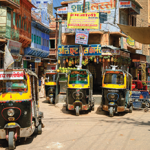On Friday night at the conference, we went to a dinner in an office building near Foggy Bottom. Because this building had two floors of State Department offices, security was high. We had to show picture IDs and undergo a search worthy of the airport where both our belongings and bodies were scanned with metal detectors. Happily, we all made it through with flying colors and could share the festivities together.
There is no city in the United States that can produce vistas as stirring and majestic as Washington, and we were lucky to have a brilliant, clear night. From our vantage on the top floor of the building, we could see all of the monuments shining under the evening sky as flickering wing lights demarcated the roaring descent of planes to Reagan National Airport.
After champagne and hors d’oeuvres, I sat down at a table with people from four continents. While enjoying salmon and a fine pinot noir, I spoke to one of three rheumatologists in the whole country of Kenya and heard of his struggles to treat inflammatory arthritis with old medicines that were nevertheless in short supply. On the other side of the table, a rheumatologist from South Africa relayed a similar story of treating the very poor in his country, emphasizing the need for education about new treatments and the value of contacts between rheumatologists from the developed world and his staff. Although the United States has great medical needs, these can pale in comparison with those of much of the rest of the world, where access to care can seem precarious if not illusory.
Vision for the Next Decade
One of the goals of the conference was the establishment of an agenda for the future, as the “decade” becomes “the decades.” We had two preliminary sessions before an assembly of the whole conference. The first session divided us by interest, such as arthritis, spine disease, and trauma. In the second session, we were re-sorted by region, including North America, South America, Middle East, Europe, Africa, Asia, and the Pacific. In these groups, using an informal Delphi process, we established priorities both for our disease area (e.g., increased recognition of early inflammatory arthritis) and our region (e.g., increased multidisciplinary research). The process will continue in the coming years, but I came away with the strong feeling that the time is right for American (and European) rheumatologists to expand their perspective and adopt a more global view.

